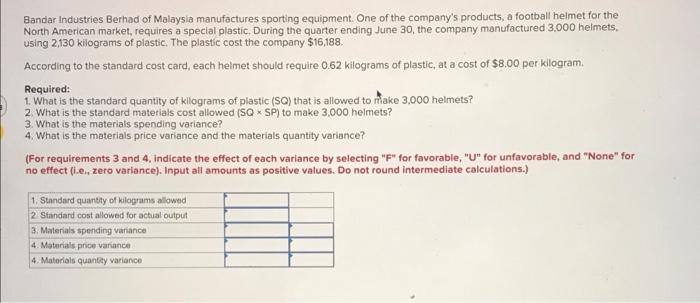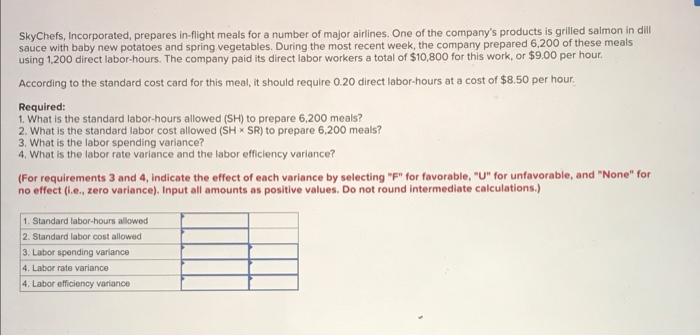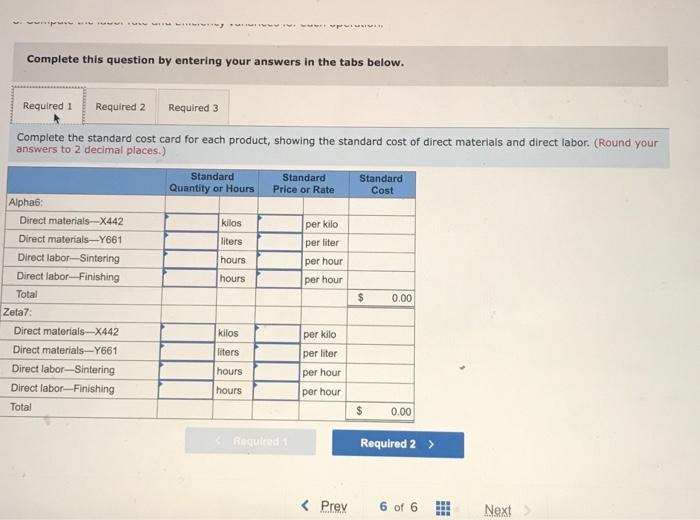Answered step by step
Verified Expert Solution
Question
1 Approved Answer
PLEASE ANSWER ALL 4 !!!!!!!! WILL !!! Bandar Industries Berhad of Malaysia manufactures sporting equipment. One of the company's products, a football helmet for the
PLEASE ANSWER ALL 4 !!!!!!!! WILL !!! 




Bandar Industries Berhad of Malaysia manufactures sporting equipment. One of the company's products, a football helmet for the North American market, requires a special plastic. During the quarter ending June 30, the company manufactured 3,000 helmets, using 2,130 kilograms of plastic. The plastic cost the company $16,188. According to the standard cost card, each helmet should require 0.62 kilograms of plastic, at a cost of $8.00 per kilogram. Required: 1. What is the standard quantity of kilograms of plastic (SQ) that is allowed to make 3,000 helmets? 2. What is the standard materials cost allowed (SQ SP) to make 3,000 helmets? 3. What is the materials spending variance? 4. What is the materials price variance and the materials quantity variance? (For requirements 3 and 4, indicate the effect of each variance by selecting "F" for favorable, "U" for unfavorable, and "None" for no effect (i.e., zero variance). Input all amounts as positive values. Do not round intermediate calculations.) 1. Standard quantity of kilograms allowed 2. Standard cost allowed for actual output 3. Materials spending variance 4. Materials price variance 4. Materials quantity variance SkyChefs, Incorporated, prepares in-flight meals for a number of major airlines. One of the company's products is grilled salmon in dill sauce with baby new potatoes and spring vegetables. During the most recent week, the company prepared 6,200 of these meals using 1,200 direct labor-hours. The company paid its direct labor workers a total of $10,800 for this work, or $9.00 per hour. According to the standard cost card for this meal, it should require 0.20 direct labor-hours at a cost of $8.50 per hour. Required: 1. What is the standard labor-hours allowed (SH) to prepare 6,200 meals? 2. What is the standard labor cost allowed (SH SR) to prepare 6,200 meals? 3. What is the labor spending variance? 4. What is the labor rate variance and the labor efficiency variance? (For requirements 3 and 4, indicate the effect of each variance by selecting "F" for favorable, "U" for unfavorable, and "None" for no effect (i.e., zero variance). Input all amounts as positive values. Do not round intermediate calculations.) 1. Standard labor-hours allowed 2. Standard labor cost allowed 3. Labor spending variance 4. Labor rate variance 4. Labor efficiency variance Logistics Solutions provides order fulfillment services for dot.com merchants. The company maintains warehouses that stock items carried by its dot.com clients. When a client receives an order from a customer, the order is forwarded to Logistics Solutions, which pulls the item from storage, packs it, and ships it to the customer. The company uses a predetermined variable overhead rate based on direct labor-hours. In the most recent month, 190,000 items were shipped to customers using 8,300 direct labor-hours. The company incurred a total of $29,050 in variable overhead costs. According to the company's standards, 0.03 direct labor-hours are required to fulfill an order for one item and the variable overhead rate is $3.55 per direct labor-hour. Required: 1. What is the standard labor-hours allowed (SH) to ship 190,000 items to customers? 2. What is the standard variable overhead cost allowed (SH SR) to ship 190,000 items to customers? 3. What is the variable overhead spending variance? 4. What is the variable overhead rate variance and the variable overhead efficiency variance? (For requirements 3 and 4, indicate the effect of each variance by selecting "F" for favorable, "U" for unfavorable, and "None" for no effect (i.e., zero variance). Input all amounts as positive values. Do not round intermediate calculations.) 1. Standard quantity of labor-hours allowed 2. Standard variable overhead cost allowed 3. Variable overhead spending variance 4. Variable overhead rate variance 4. Variable overhead efficiency variance Mickley Corporation produces two products, Alpha6s and Zeta7s, which pass through two operations, Sintering and Finishing. Each of the products uses two raw materials-X442 and Y661. The company uses a standard cost system, with the following standards for each product (on a per unit basis). Raw Material Standard Labor Tine Product Alpha6 X442 3.0 kilos 7661 3.0 liters Sintering 0.30 hours Finishing 1.10 hours Zeta? 5.0 kilos 5.0 liters 0.40 hours 1.20 hours Information relating to materials purchased and materials used in production during May follows: Purchase Cost Material Purchases 15,300 kilos 16,300 liters Standard Price $ 2.70 per kilo X442 Y661 Used in Production 9,800 kilon 14,300 liters $ 44,370 $ 26,080 $ 1.70 per liter The following additional information is available: a. The company recognizes price variances when materials are purchased. b. The standard labor rate is $23.00 per hour in Sintering and $21.50 per hour in Finishing. c. During May, 1,320 direct labor-hours were worked in Sintering at a total labor cost of $32,340, and 2,980 direct labor-hours were worked in Finishing at a total labor cost of $70,030. d. Production during May was 1,900 Alpha6s and 900 Zeta7s. Required: 1. Complete the standard cost card for each product, showing the standard cost of direct materials and direct labor. 2. Compute the materials price and quantity variances for each material. 3. Compute the labor rate and efficiency variances for each operation. Complete this question by entering your answers in the tabs below. 6 of 6 # ** Next > Bandar Industries Berhad of Malaysia manufactures sporting equipment. One of the company's products, a football helmet for the North American market, requires a special plastic. During the quarter ending June 30, the company manufactured 3,000 helmets, using 2,130 kilograms of plastic. The plastic cost the company $16,188. According to the standard cost card, each helmet should require 0.62 kilograms of plastic, at a cost of $8.00 per kilogram. Required: 1. What is the standard quantity of kilograms of plastic (SQ) that is allowed to make 3,000 helmets? 2. What is the standard materials cost allowed (SQ SP) to make 3,000 helmets? 3. What is the materials spending variance? 4. What is the materials price variance and the materials quantity variance? (For requirements 3 and 4, indicate the effect of each variance by selecting "F" for favorable, "U" for unfavorable, and "None" for no effect (i.e., zero variance). Input all amounts as positive values. Do not round intermediate calculations.) 1. Standard quantity of kilograms allowed 2. Standard cost allowed for actual output 3. Materials spending variance 4. Materials price variance 4. Materials quantity variance SkyChefs, Incorporated, prepares in-flight meals for a number of major airlines. One of the company's products is grilled salmon in dill sauce with baby new potatoes and spring vegetables. During the most recent week, the company prepared 6,200 of these meals using 1,200 direct labor-hours. The company paid its direct labor workers a total of $10,800 for this work, or $9.00 per hour. According to the standard cost card for this meal, it should require 0.20 direct labor-hours at a cost of $8.50 per hour. Required: 1. What is the standard labor-hours allowed (SH) to prepare 6,200 meals? 2. What is the standard labor cost allowed (SH SR) to prepare 6,200 meals? 3. What is the labor spending variance? 4. What is the labor rate variance and the labor efficiency variance? (For requirements 3 and 4, indicate the effect of each variance by selecting "F" for favorable, "U" for unfavorable, and "None" for no effect (i.e., zero variance). Input all amounts as positive values. Do not round intermediate calculations.) 1. Standard labor-hours allowed 2. Standard labor cost allowed 3. Labor spending variance 4. Labor rate variance 4. Labor efficiency variance Logistics Solutions provides order fulfillment services for dot.com merchants. The company maintains warehouses that stock items carried by its dot.com clients. When a client receives an order from a customer, the order is forwarded to Logistics Solutions, which pulls the item from storage, packs it, and ships it to the customer. The company uses a predetermined variable overhead rate based on direct labor-hours. In the most recent month, 190,000 items were shipped to customers using 8,300 direct labor-hours. The company incurred a total of $29,050 in variable overhead costs. According to the company's standards, 0.03 direct labor-hours are required to fulfill an order for one item and the variable overhead rate is $3.55 per direct labor-hour. Required: 1. What is the standard labor-hours allowed (SH) to ship 190,000 items to customers? 2. What is the standard variable overhead cost allowed (SH SR) to ship 190,000 items to customers? 3. What is the variable overhead spending variance? 4. What is the variable overhead rate variance and the variable overhead efficiency variance? (For requirements 3 and 4, indicate the effect of each variance by selecting "F" for favorable, "U" for unfavorable, and "None" for no effect (i.e., zero variance). Input all amounts as positive values. Do not round intermediate calculations.) 1. Standard quantity of labor-hours allowed 2. Standard variable overhead cost allowed 3. Variable overhead spending variance 4. Variable overhead rate variance 4. Variable overhead efficiency variance Mickley Corporation produces two products, Alpha6s and Zeta7s, which pass through two operations, Sintering and Finishing. Each of the products uses two raw materials-X442 and Y661. The company uses a standard cost system, with the following standards for each product (on a per unit basis). Raw Material Standard Labor Tine Product Alpha6 X442 3.0 kilos 7661 3.0 liters Sintering 0.30 hours Finishing 1.10 hours Zeta? 5.0 kilos 5.0 liters 0.40 hours 1.20 hours Information relating to materials purchased and materials used in production during May follows: Purchase Cost Material Purchases 15,300 kilos 16,300 liters Standard Price $ 2.70 per kilo X442 Y661 Used in Production 9,800 kilon 14,300 liters $ 44,370 $ 26,080 $ 1.70 per liter The following additional information is available: a. The company recognizes price variances when materials are purchased. b. The standard labor rate is $23.00 per hour in Sintering and $21.50 per hour in Finishing. c. During May, 1,320 direct labor-hours were worked in Sintering at a total labor cost of $32,340, and 2,980 direct labor-hours were worked in Finishing at a total labor cost of $70,030. d. Production during May was 1,900 Alpha6s and 900 Zeta7s. Required: 1. Complete the standard cost card for each product, showing the standard cost of direct materials and direct labor. 2. Compute the materials price and quantity variances for each material. 3. Compute the labor rate and efficiency variances for each operation. Complete this question by entering your answers in the tabs below. 6 of 6 # ** Next > 




Step by Step Solution
There are 3 Steps involved in it
Step: 1

Get Instant Access to Expert-Tailored Solutions
See step-by-step solutions with expert insights and AI powered tools for academic success
Step: 2

Step: 3

Ace Your Homework with AI
Get the answers you need in no time with our AI-driven, step-by-step assistance
Get Started


